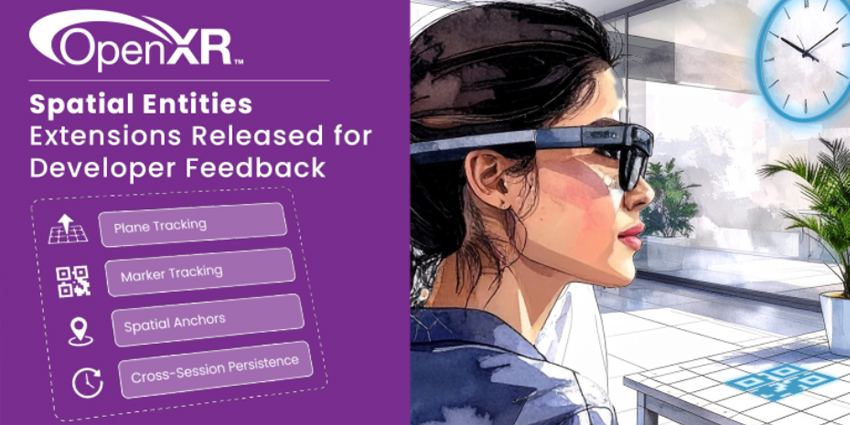The Khronos OpenXR Working Group recently updated its OpenXR framework with new extensions to support standardisation across XR-ready devices.
The mvoe sees OpenXR OS now equipped with new Spatial Entities Extensions via its public review channel, increasing support for interoperable XR spatial experiences.
Interestingly, the move comes just as Google’s AndriodXR OS emerges as a framework for agile XR applications and hardware that covers a wide range of devices from various manufacturers.
Ron Bessems, chair of the OpenXR Working Group, said:
The OpenXR Spatial Entities Extensions address one of the most critical needs expressed by our developer community, and represent a significant milestone in our mission to create a powerful and truly interoperable XR ecosystem. The Spatial Entities Extensions are carefully defined as a discoverable and extensible set of functionality, providing a firm foundation for spatial applications today, and enabling continued innovation in portable spatial computing into the future.
The update introduces features such as consistent cross-platform support for detecting and tracking planes and markers, precise spatial anchors, and cross-session persistence, all tailored for the expanding XR hardware market.
These new extensions enhance the OpenXR API by enabling the detection and tracking of features in the user’s physical environment, along with the precise positioning and anchoring of virtual content in relation to those features. This includes virtual content that remains persistent across different XR device sessions.
By standardising the spatial computing API, OpenXR significantly reduces development time and costs. It eliminates the need to write device-specific code for each platform, allowing developers to focus their efforts on creating innovative features instead of managing platform-specific implementations.
Praveen Babu J D, PICO Open XR tech leader, spoke on the recent OpenXR developments, adding:
PICO is proud to have contributed to the design of the OpenXR Spatial Entities Extensions and to be among the first to implement runtime support. By helping define this core capability, we’re enabling developers to build more persistent, shareable, and spatially aware XR experiences across platforms.
More on AndriodXR
The news comes after Google I/O, where the company announced a variety of new products, including expansions to its Gemini AI framework. This expansion is partly fueled by Google’s AndroidXR initiative, which involves collaboration with key players in the XR industry to create mixed reality and augmented reality devices that incorporate immersive and AI technologies.
“That’s exactly why we’re building Android XR,” remarked Shahram Izadi, the leader of Google’s AndroidXR development team, during the event, who also said:
From headsets to glasses and everything in between. We believe there’s not a one size fits all for XR and you’ll use different devices throughout your day. For example, for watching movies, playing games, or getting work done, you’ll want an immersive headset. But when you’re on the go, you’ll want lightweight glasses that can give you timely information without reaching for your phone.
Izadi discussed how the Android XR team collaborates with Samsung and Qualcomm to develop new Gemini AI use cases for emerging XR devices, including the highly anticipated Moohan headset, which Izadi referred to as “the first Android XR device.”
Notably, Izadi mentioned that Samsung’s Moohan headset is expected to be available for purchase later this year, likely around Meta Connect, a popular period for XR hardware releases.
Google introduced Android XR, a new operating system designed specifically for extended reality, late last year. During the announcement, the company highlighted the significance of Gemini AI assistants in enhancing user interactions with headsets and improving visual experiences.
Built on a familiar Android foundation, the XR operating system supports various existing mobile and tablet applications, as well as content created specifically for Android XR. This development addresses a critical barrier to the broader adoption of XR technology: users need access to a diverse range of applications and engaging services to justify their investment in XR devices.
The Android XR operating system aims to advance the future of artificial intelligence, augmented reality, and virtual reality experiences on headsets and smart glasses. Currently, Android XR is in a preview stage for developers only, with a wider release anticipated in the future.
Now, with OpenXR focusing on driving interoperable XR developments, the stage for a true Andriod-owered XR ecosystem is coming together.







